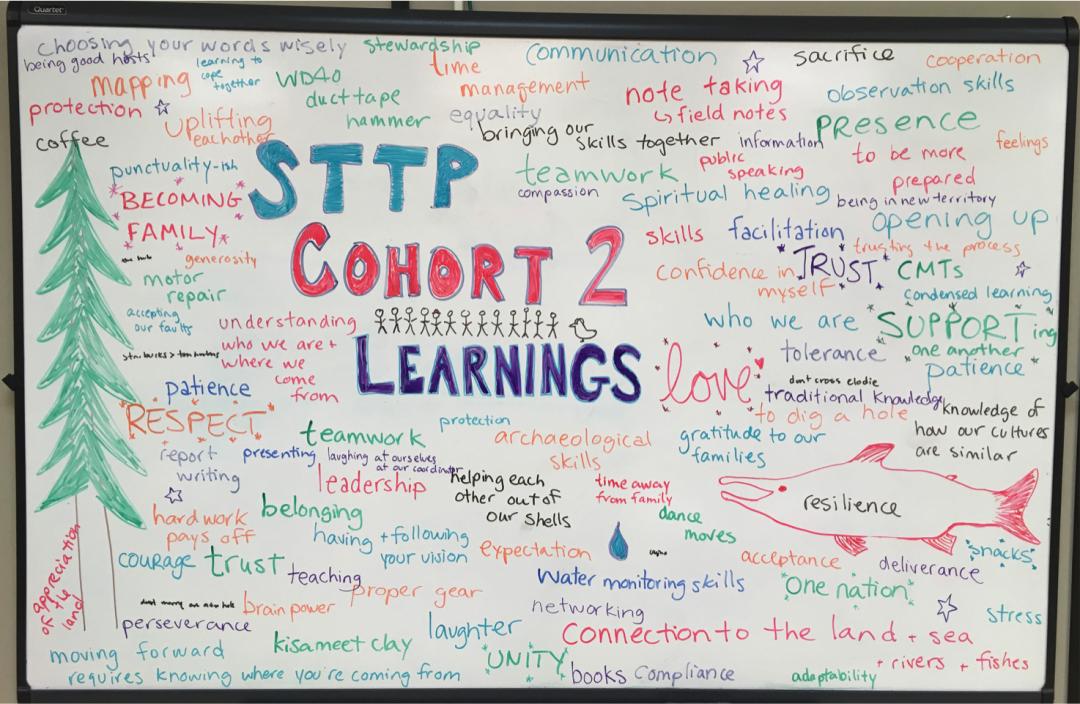Tips on Successful Training: Elder Support, Inter-Generational Learning, and Becoming Family

No matter where you are in developing your Indigenous Guardian program, thinking about training to support your Indigenous Guardians is likely on your mind. Indigenous Guardians need a variety of knowledge and skills, from cultural knowledge about their territory to necessary safety certifications. There are many ways to approach training - some Nations develop custom programs delivered on the land with Elders and other knowledge keepers. Other Nations work in partnership with educational institutions to develop training that gives their Indigenous Guardians industry standard certification in topics like environmental monitoring or archaeological site inventory.
Members of the Coastal First Nations – Great Bear Initiative (CFN-GBI) in coastal British Columbia developed a custom training program with Vancouver Island University. Three cohorts of students have now completed the Stewardship Technicians Training Program (STTP). The CFN-GBI is conducting a third party evaluation this year to gather lessons learned about what has been successful and identify where there is room for improvement. As more Nations grapple with how to go about training their Indigenous Guardian crew, it will be helpful to know what has worked or not worked in other places.
Elodie Button, CFN’s training coordinator, recently shared her reflections about the STTP with representatives of several Indigenous organizations and communities in the North West Territories.
In the STTP, participants started the program with different experience and knowledge, having spent their lives growing up and working on their territories. An important element of how the STTP was delivered was to encourage inter-generational learning - everyone in the classroom was at times both a student and a teacher,. Space was created to share their experiences and learn from others. This approach created a supportive learning environment that uplifted participants and established a strong sense of family.
“We realized early on that it was essential to have an Elder present and connected to the program. They grounded students in the importance of tending to mental health, well-being and spiritual connection. I believe that this has served everyone beyond the two year training program,” says Elodie.
“We tried as much as possible to support participant’s individual needs. As the community coordinator, I did my best to earn the trust of participants and make sure everyone felt they could share what might be coming up for them that was affecting their ability to learn. Sometimes it meant being there to listen, other times it meant getting additional support from instructors to complete course requirements of exams.”
CFN GBI will share the results of their evaluation that will involve interviewing past participants, Stewardship Directors from participating Nations, course instructors, and institutional partners. It will use a wholistic lens to find out what elements have had the biggest impact for Indigenous Guardians training.
Tips:
- Training programs will evolve over time based on changing needs and lessons learned as we go.
- Ideally the training program will focus directly on the skills and abilities students will be using in their work.
- A strong relationship between the educational institution and community partners is key – there can be bumps along the road and being able to creatively respond together is important.
- Maintaining excellent communication with the funder is important in order to productively respond to the dynamic nature of the program. This will help to address unexpected changes.
- A community coordinator plays a key role in supporting students to learn – the role is 1 part evaluator, 1 part logistical support, 1 part curriculum and teaching expert and 10 parts kind, compassionate friend.
- Students come together as a family and this sets them up for success.
- Fostering inter-generational learning in the classroom strengthens everyone's experience.
- Adaptable, flexible programming will adjust to the changing context of Indigenous Stewardship.
- Consider funding for stipends and living allowance while doing training. It is already hard enough to be away from family and home and the additional support is helpful.
- Instructors are ideally Indigenous and if not, then it is critical that they are familiar with teaching in an Indigenous context.
- Having an Elder, life coach, or counsellor connected to the program can provide essential mental health, well-being and spiritual support to students.
See also the story 'Building Knowledge, Skills and Family through Stewardship Technicians Training Program on BC's Coast'.